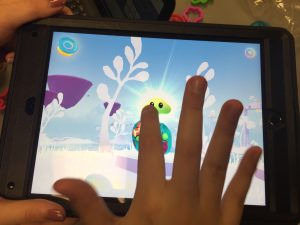“How can learning be distributed and accelerated with access to digital resources and specialized tools and what are the implications of learning math and science just in time and on demand?
We want to bring back the “wow” of learning in the classroom and help to avoid memorization versus understanding. Science classrooms often focus heavily on memorizing key terms, relationships, and interactions. Yet memorization is not enough for true learning. Yes we may have students acing exams based on a regurgitation of information, but the depth of that understanding is limited. We have an opportunity to create a learning environment that allows students to make personal constructions of meanings about natural phenomena resulting from their interactions with both physical and virtual events in their daily lives (Driver, Asoko, Leach, Scott & Mortimer, 1994). It is essential that we design learning activities in a way that encourages the “encounter” with their natural world and goes beyond the limited concepts that are found on the page alone. This page learning also limits the access to information and the self pacing that students can engage in using personal devices. Finally the page is isolating and does not take full advantage of learning constructed in a social context where students are actively engaged with others in attempting to understand and interpret this phenomena for themselves sharing differing perspectives and challenging each other with questions (Driver, Asoko, Leach, Scott & Mortimer, 1994). Students can once again experience encounters that motivate them to exclaim “how did you do that?!”
Augmented Reality(AR) allows us to take advantage of the supercomputers found in most of our students pockets. Students are already using their cell phones seamlessly to communicate and share information with their peers throughout the day, and we can build upon this social interaction by combining it with engaging learning tools found on the same device (Dunleavy, Dede & Mitchell, 2009). When we introduce AR for mobile devices we provide instant access to multiple layers of reality encouraging an encounter while the students are in the midst of their natural environments with their peers. This is a recipe for constructing knowledge. “AR games can be more than a standalone experience and instead integrate into the daily lives of students, challenging them to think differently about their communities and themselves. AR has the potential to engage students by seeing information in context and providing a platform through which they can creatively explore content by designing and exploring scenarios through the lens of games” (Klopfer & Sheldon, 2010, p.93).
Yesterday I was working with a group of students who were studying the human cell as part of their science program. This natural phenomena is not easily experienced with our naked eye beyond what has been described in a book. We decided to introduce three choices of different augmented reality experiences for the students to work together to make meaning. The first was using the Quivervision education pack that allowed students to colour and label a cell then scan it to bring it to life. The second was using the Play-doh Touch to build a human cell using playdough and then bring it to life through animation and AR. Finally they could use the Merge Cube to explore Mr. Body and Anatomy AR+. The classroom became an explosion of conversations, questions, excitement and engagement with every student asking “how did you do that” providing an opportunity for the teacher to demonstrate, challenge, and guide. Their classroom reality was enhanced and added to with simple tools that took advantage of the phone in their pockets.




As these tools become more prolific I wonder what platforms will become available for teachers and to create their own AR content without having a coding background? Are we asking too much from teachers to not only use these tools but to create content as well?
What AR tools are the most valuable to you in your classrooms?
Trish
References
Driver, R., Asoko, H., Leach, J., Scott, P., & Mortimer, E. (1994). Constructing scientific knowledge in the classroom. Educational researcher, 23(7), 5-12. Available in Course Readings.
Dunleavy, M., Dede, C., & Mitchell, R. (2009). Affordances and limitations of immersive participatory augmented reality simulations for teaching and learning. Journal of science Education and Technology, 18(1), 7-22.
Klopfer, E., & Sheldon, J. (2010). Augmenting your own reality: Student authoring of science‐based augmented reality games. New Directions for Student Leadership, 2010(128), 85-94.
